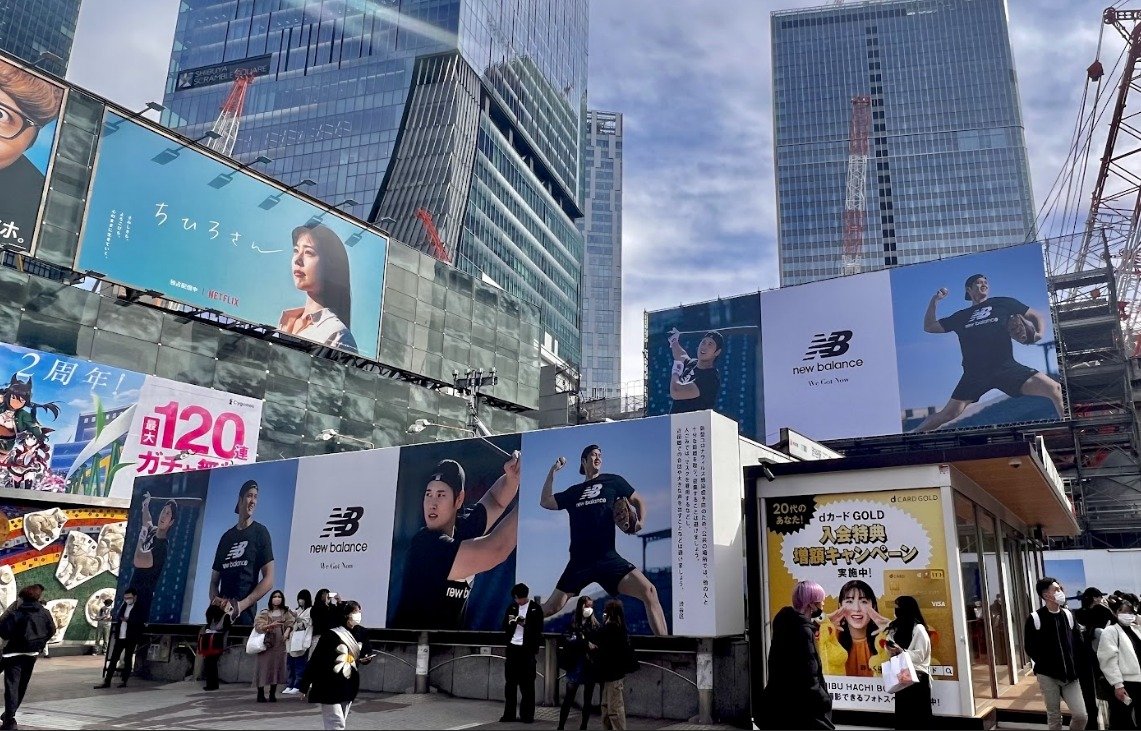A letter from… Japan
As part of our new ‘A letter from’ series, based on our teams’ experiences visiting markets, International Team member Su showcases the incredible outdoor opportunities available to clients in Japan. She reports:
Japan is a unique blend of ancient traditions and modern innovations, where culture and technology merge seamlessly. I recently had the opportunity to explore their advertising landscape while on a one-month business and combined leisure trip, where I backpacked across Japan from the North to the South!
I gained incredible insight into their OOH advertising landscape, observing latest trends, accessing the most recent case studies, seeing them live, networking with key media owners, as well as emerging vendors, with brilliant creative and experimental assets and skills.
OOH Landscape In Japan
Japan is known for its vibrant, bustling cities, and Tokyo is no exception. With a population of over 13 million, Tokyo is a hub for commerce, culture, and entertainment, making it an ideal location for OOH advertising. Japan has a rich out-of-home advertising scene that ranges from traditional billboards and transit ads to cutting-edge digital installations.
Tokyo takes things to a whole new level with its innovative and experiential OOH advertising. I was blown away by the sheer number of digital billboards and screens that light up the streets, especially in popular areas like Shibuya and Shinjuku. But what really caught my eye were the wall murals and sustainable OOH ads in areas like Koenji and Shimokitazawa, which were not only visually stunning but also aligned with the values of today's eco-conscious consumers.
According to a report by Dentsu Inc., Japan's OOH advertising market was worth approximately 401.5 billion yen (roughly $3.5 billion USD) in 2020, making it the third biggest OOH market in the world after the USA and China. However, despite the enormous potential, many businesses still hesitate to enter Japan's OOH market due to its cluttered, competitive landscape, with more than 1.5 million outdoor ads in Tokyo alone. While we are used to seeing a maximum of 3 to 5 major OOH media owners in European countries, there are hundreds of media owners in Japan which can cause the market to be very challenging to navigate.
As an OOH specialist, it was exhilarating to see in person the digital signages we book for luxury clients in premium areas like Omotesando, Roppongi, and Ginza. Beyond the glitz and glamour, Tokyo's OOH advertising scene reflects the city's dynamic and ever-evolving culture. It's a feast for the senses and an opportunity for businesses to showcase their creativity and connect with consumers on a deeper level.
OOH Trends in Japan
One trend that's been gaining traction in Japan is digital screens and billboards. They are everywhere in Tokyo, lighting up the cityscape with eye-catching visuals and animations that are hard to miss, but what sets Japan's digital billboards apart is their interactivity. These screens are equipped with sensors that detect people and adjust their content accordingly. For example, a billboard might show an ad for a clothing brand, but when someone walks by, the billboard might change to show a video of people wearing the clothes in real-life situations, creating a more engaging, personalised experience for viewers.
Another trend that's making waves is sustainability. As consumers become more environmentally conscious, brands are starting to rethink their advertising strategies. Instead of using traditional billboards, they're turning to more eco-friendly alternatives. Brands can use recycled materials in production, or non-toxic paint for wall murals. Sustainable OOH ads not only look great but they also convey a brand's commitment to sustainability, resonating with consumers who value environmental responsibility.
Lastly, experiential OOH advertising is also on the rise in Japan. Brands are creating immersive installations that invite consumers to step into a world of their own. For example, a coffee brand might create a giant coffee cup installation that people can climb into and take pictures of themselves inside. This type of advertising not only creates a memorable experience for consumers, but also generates social media buzz, amplifying a brand's reach further.
Creative and Experimental OOH Campaigns in Japan
One of the most creative and captivating campaigns in recent memory was executed last summer on the video wall in Shinjuku, capturing the attention of Japanese people across the country. The campaign featured none other than MLB® The ShowTM 22's cover star, Ohtani, showcasing his impressive skills in the game for the promotion of the show. From pitching to hitting and running the bases, every move of the Angels' two-way star player was expertly reproduced on the video wall.
What made this campaign truly special was that all of Ohtani's signature moves were showcased at their actual recorded speeds, allowing viewers to witness the true extent of his abilities. Fans of Ohtani in Japan who haven't had the luxury of flying to Angel Stadium to cheer for their "native son" have had to settle for TV broadcasts. But with this campaign, commuters going through Tokyo's Shinjuku Station were able to witness a special Ohtani experience that was previously only available to a select few.
One particular highlight of the campaign was when Ohtani threw a lightning-fast 101.6 mph ball from the mound, or when he hit a ball with an exit velocity of 119.1 mph, clobbering it with remarkable force. Through this campaign, those passing through Shinjuku Station had the chance to witness the awe-inspiring talent of one of baseball's brightest stars. The campaign succeeded in generating buzz and excitement for both the game and Ohtani himself, making it an outstanding example of what creative campaigns can achieve. As OOH advertising continues to evolve, we can expect to see more brands experimenting with new, exciting ways to connect with consumers.




